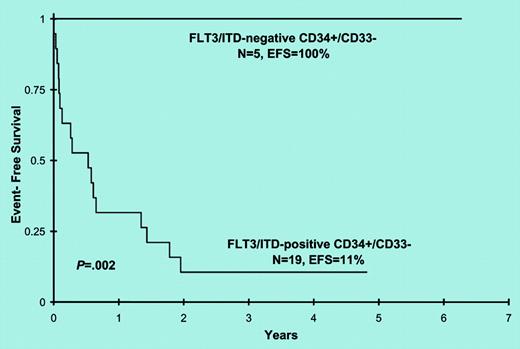Comment on Pollard et al, page 2764
Most AML patients with FLT3/ITD mutations have poor outcomes. This article by Pollard and colleagues suggests that the explanation, not surprisingly, may be found at the root of the problem, the leukemia stem cell.
Acute myeloid leukemia (AML) is organized into a hierarchy that in some respects parallels normal hematopoiesis.1 Primitive hematopoietic precursor cells acquire mutations that eventually result in transformation to leukemia. The exact stem or progenitor cell that eventually becomes the leukemia stem cell probably varies from case to case, but the more primitive it is, the less curable the leukemia is likely to be.
FLT3/internal tandem duplication (ITD) mutations have emerged as the most common molecular abnormality in AML, and only a minority of patients harboring these mutations can be cured.2 It has been postulated that FLT3 mutations are relatively late hits in leukemogenesis because they are not by themselves capable of inducing transformation and are occasionally lost (or acquired) at relapse.3,4 Nonetheless, previous work using nonobese diabetic/severe combined immunodeficient (NOD/SCID) engraftment and polymerase chain reaction (PCR) assays of CD34+/CD38- fractions of AML samples suggests that FLT3 mutations are present in leukemia stem cells.5 The findings of Pollard and colleagues, in this issue of Blood, offer another opportunity to understand how FLT3 mutations fit into the stem cell paradigm of leukemia.
These authors examined the FLT3 mutation status of 24 diagnostic AML samples from pediatric patients harboring FLT3/ITD mutations. Their purpose was to determine if the FLT3 mutations were present in mature versus immature myeloid cell populations and whether this affected the clinical outcome. They sorted the samples into CD34+/CD33- (more primitive) or CD34+/CD33+ (less primitive) progenitor cell fractions and then used those cells to generate granulocyte-macrophage colony-forming units (CFU-GMs) and erythroid burst-forming units (BFU-Es) in colony assays. Using patient-specific FLT3 primers, PCR was used to determine mutation status of the sorted cells and of CFU-GMs and BFU-Es plucked from the colony plates. They were able to detect the FLT3 mutations in the more differentiated CD34+/CD33+ cells from all 24 of the samples. However, 5 of the 24 samples had no detectable mutation in the less mature CD34+/CD33- cells or in any of the colonies. In other words, the early progenitor cells of these 5 patients lacked the FLT3 mutations. The other 19 patients did harbor the mutations within the CD34+/CD33- fraction, and in some cases the mutations were present in both CFU-GM and BFU-E colonies, implying derivation from a precursor with bilineage potential. Strikingly, the 5 patients in whom the mutation was present in only the more differentiated cell fraction had dramatically better clinical outcomes than the other 19 patients (see figure).
Event-free survival for patients with and without FLT3/ITD detection in CD34+/CD33-progenitor cells. See the complete figure in the article beginning on page 2764.
Event-free survival for patients with and without FLT3/ITD detection in CD34+/CD33-progenitor cells. See the complete figure in the article beginning on page 2764.
Despite these fascinating findings, the exact role of FLT3 mutations in leukemogenesis and how they affect prognosis are still not clear. In the group of 5 patients with the good outcome as described in this paper, did the FLT3 mutations arise as part of the transformation process in a more committed progenitor cell (much like 15;17 translocations are thought to occur in acute promyelocytic leukemia), resulting in a more curable disease? Or were they late hits in the progenitor cells of an already established leukemia? Just how deep into the roots of the hematopoietic system do these FLT3 mutations go? ▪


This feature is available to Subscribers Only
Sign In or Create an Account Close Modal